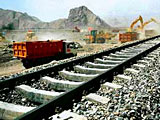 Despite being built across an area where earthquakes frequently occur, the Qinghai-Tibet railway under construction in western China should resist violent tremors thanks to preventive measures being taken, experts say.
Despite being built across an area where earthquakes frequently occur, the Qinghai-Tibet railway under construction in western China should resist violent tremors thanks to preventive measures being taken, experts say.
Known as the highest railway of its kind in the world, the 1,100-kilometre line is being built on the Qinghai-Tibet Plateau at an altitude of over 4,000 meters, linking Golmud, a major city in Qinghai Province and Lhasa, the capital of the Tibet Autonomous Region.
"Since last year we have mobilized many engineers and technicians to make a thorough geological survey in the seismic belt along the railway line," said Lu Ming, vice-director of the Seismic Research Center at the China Seismological Bureau.
"They have provided a detailed analysis of the location of major fault zones, the possibility of quakes and the magnitude of possible quakes.
"Although violent quakes have occurred frequently on the Qinghai-Tibet Plateau, it does not rule out the feasibility of building a railway there.
"We can reduce or avoid the quake threat as long as we detect accurately the geological conditions under the railway line and manage to go around the seismic belt or take other preventive measures."
According to Zhao Shiyun, general engineer of the Qinghai-Tibet Railway Construction Headquarters, a violent earthquake will only cause the link to vibrate slightly and any damaged rails can be quickly repaired.
Li Jincheng, a senior engineer supervising construction, said the line is designed to cross the seismic belt at right angles, which should reduce damage to the railway as much as possible.
"We try to avoid digging tunnels or building bridges when a railway crosses the seismic belt," Li said.
"Instead, we use shallow foundations for rails, which may reduce quake damage to a minimum.
"When tunnels or bridges have to be built, we try to reduce their span and design their structure in a special way, which aims to help them survive an earthquake measuring eight on the Richter Scale."
On November 14 last year, a serious earthquake measuring 8.1 on the Richter Scale jolted the Kunlun Pass on the Qinghai-Tibet Plateau.
"The earthquake had no remarkable impact on the railway," said Shi Jiaming, an official with a construction team working near the quake site.
"We saw the foundations of the rails shaking when the earthquake took place, but they did not break," Shi added.
(Xinhua News Agency November 25, 2002)
|

